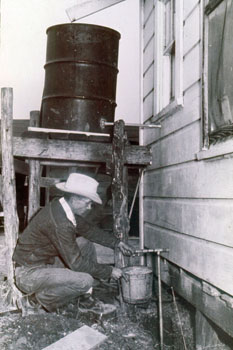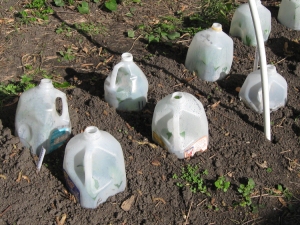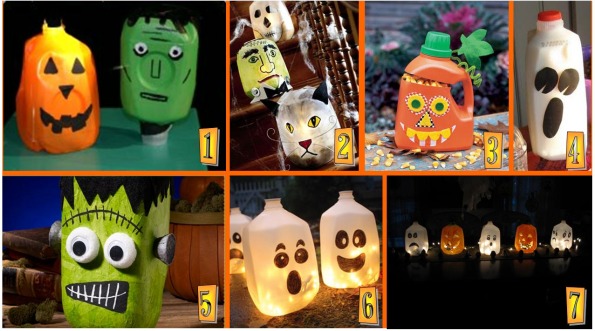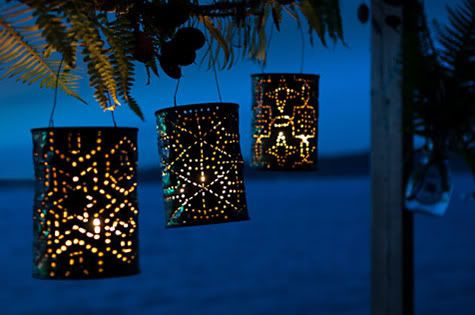While the house is clearly old enough that it would have utilized a rain collection system historically. The town's homes didn't have indoor plumbing for bathrooms until the 1970s, so I'm certain that it wasn't until then that indoor water usage fully was embraced. Though an indoor kitchen pump may have existed.
I do not know of any cistern being buried on the property. Other property in town have beehive brick cisterns at the edge of the homes, so it could be possible that at one time something similar existed. Or it may have been a simple wooden barrel or steel drum prior to indoor water, that was used to collect rain fall as it came off the roof.
Both systems had their period of usage.
There are numerous designs out there that offer people ways in which to include a rain barrel for watering garden plants or landscapes.
Some people have plumbed the barrels so that they are multi-barrel systems that allow a great deal of water storage as it comes off the roof, stored in sealed barrels that are interconnected by pvc pipes.
My first rain barrel was much simpler, as it was merely a plastic trash barrel, with a large plastic window screen secured over its open top, to keep mosquitoes and debris from getting into the water.
It is important if you collect your own rain water, that you make sure that it is not illegal in your state to do so. Many Videos are found online regarding rain barrel system designs.
When harvesting rain water Its also important to consider the quality of water you get once the rain runs over your roof material and down into your collection barrels.
Some people don't consider the material that their roof is made from. However, this material can contaminate your water and make it unsafe to drink or use on food crops such as vegetable gardens.
The roof on our Gallery House is steel roofing panels, which are one of the better choices for rain collection, if you aren't going to utilize solar-roofing panels or green roofing choices to create a "Green" roof. Ours is simply the good old fashioned steel roof that happens to be green!
It is also important to be aware of the need of filtration. Not only does contaminants enter the water via roof materials, but also pathogens can be present in your water storage and drainage system that will multiply and can cause grave harm to you, your animals and your garden if not properly filtered out.
Additional contamination can occur if you leave your barrel open.
While most people think of the system to be clean, it has the potential of being a nursery space for mosquito larva.
It doesn't take much effort to deny mosquitos from using your home's rain barrel as their personal nursery and by taking a few moments to secure your water source you also secure your family's comfort by denying a few thousand future mosquitos from dining on you & your family!
Its important to remember that mosquitos can live in a very small amount of water
Even a bucket set at the edge of a building to collect water for your houseplants is a nursery space for millions of mosquitos over one summer. The solution is simple. Rather than use oil or other contamination to your water supply, simply cover your collection buckets & barrels with a fine synthetic screen. Recycled window screening fabric works great for this purpose.
My frugal method for securing the screen was to take and cut the screen several inches beyond the diameter of the barrel, draping it down all sides about 6 inches. Then I took a bungee cord and wrapped it around the barrel, stretching it to hook to itself. This bungee holds the screen tight across the surface of the barrel, denying insects (and debris) entrance into the barrel.
The rain barrel method of course is only one method of water storage, one can use (if its legal to store water in your area).
When I was growing up in the sandhills of eastern Colorado, most of our extended families' ranches had well houses which had windmills pumping water up from the deep Ogallala Aquifer.
Within the wellhouse was a water barrel that collected the water and we simply went into the building to bucket out the water needed in the kitchen.
Another type of wellhouse are those built over a natural spring. Such locations are prized by the land owners and if properly safeguarded and "plumbed" to collect the water coming up from the natural spring, can be a windfall to the land owner. These well houses can be made of wood, stone or any other building material and have been historically.
The well house can be quite plain or quite fanciful.
One could even use a standard commercially available storage shed as your well house structure.
Having a well house to store excess water is far better in many ways than having your water barrels exposed to the elements & I think you will find it is much more pleasing to the eye to hide the unattractive barrels. HOWEVER, if you live in a cold climate where water freezes in winter, don't forget to protect your water storage from freezing or empty your barrels before winter freeze.Some people bury their water storage tanks. These buried tanks historically were called Cisterns. In our local town, some exist, though they haven't been used in over 50 years. The ones here are brick & mortar beehive cisterns large enough to park a compact car into!
The cistern is called a beehive because of its round form similar to the historic skep bee hive.
The roof of such a cistern is quite intricately built with bricks stepping inward layer after layer until the opening of the cistern is quite small.
Whatever your water collection system, becoming more conscience of our water use and more importantly water waste is critical for the planet.














































